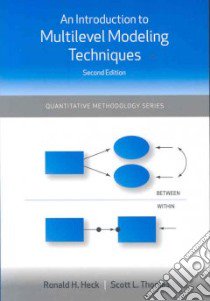An Introduction to Multilevel Modeling Techniques - 9781841697567
Un libro in lingua di Heck Ronald H. Thomas Scott L. edito da Taylor & Francis, 2008
- € 48.80
- Il prezzo è variabile in funzione del cambio della valuta d’origine
This comprehensive, applied approach to multilevel analysis is distinguished by its wide range of applications relevant to the behavioral, educational, organizational, and social sciences. Univariate and multivariate models are used to understand how to design studies and analyze data. Readers are encouraged to consider what they are investigating, their data, and the strengths and limitations of each technique before selecting their approach. Numerous examples and exercises allow readers to test their understanding of the techniques. Input programs from HLM and Mplus demonstrate how to set up and run the models.
A latent variable conceptual framework is emphasized to show the commonality of the approaches and to make each technique more accessible. The first section is devoted to conceptual issues underlying multilevel modeling, while the second section develops several types of multilevel analyses including univariate regression, structural equation, growth curve and latent change, and latent variable mixture modeling. The new edition features:
- New chapters on multilevel longitudinal and categorical models
- 80% new exercises and examples
- website at http://www.psypress.com/multilevel-modeling-techniques/ providing datasets and program setups in HLM, SPSS, Mplus, and LISREL
- Increased emphasis on how multilevel techniques are used to examine changes in individuals and organizations over time.
Ideal for introductory graduate level courses on multilevel and/or latent variable modeling, this book is intended for students and researchers in psychology, business, education, health, and sociology interested in understanding multilevel modeling. Prerequisites include an introduction to data analysis and univariate statistics.
Informazioni bibliografiche
- Titolo del Libro in lingua: An Introduction to Multilevel Modeling Techniques
- Lingua: English
- Autori : Heck Ronald H. Thomas Scott L.
- Editore: Taylor & Francis
- Collana: (Paperback)
- Data di Pubblicazione: 22 Gennaio '08
- Genere: PSYCHOLOGY
- Argomenti : Social sciences Mathematical models Social sciences Research Mathematical models
- Pagine: 268
- Dimensioni mm: 241 x 158 x 19
- ISBN-10: 1841697567
- EAN-13: 9781841697567


